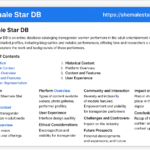Introduction to Cñims
Cñims, pronounced “se-nims,” stands for Computational Niche Information Management Systems. It is an advanced technology framework designed to streamline data processing, enhance analytics, and improve automation across various industries. As businesses continue to rely on data-driven strategies, Cñims plays a crucial role in transforming raw information into actionable insights.
In this guide, we will provide an in-depth exploration of Cñims, covering its core components, key features, applications, benefits, challenges, and future outlook. By the end of this article, you will have a solid understanding of how Cñims can revolutionize modern data management systems.
Core Components of Cñims
Cñims is built on several foundational elements that make it a powerful system for data handling and automation:
1. Artificial Intelligence (AI) Integration
Cñims leverages AI to process massive datasets, identify patterns, and generate predictive insights. Machine learning algorithms continuously improve the system’s efficiency, making it smarter over time.
2. Data Analytics and Real-Time Processing
Businesses need real-time data access to make quick decisions. Cñims ensures seamless data collection, processing, and analysis, allowing companies to respond to market trends dynamically.
3. Algorithmic Decision-Making
The system employs advanced algorithms to automate decision-making processes. From supply chain optimization to risk assessment, Cñims reduces human intervention while ensuring accuracy.
4. Modular Architecture
Cñims is designed to be highly customizable. Companies can integrate modules tailored to their specific needs, enhancing flexibility and adaptability.
Key Features of Cñims
Cñims stands out due to its impressive set of features that make it an indispensable tool for organizations.
| Feature | Description |
|---|---|
| Interoperability | Ensures seamless integration with existing data management systems. |
| Scalability | Easily adapts to business growth and evolving data needs. |
| User-Friendly Interface | Designed with an intuitive UI for easy navigation and operation. |
| Security & Compliance | Incorporates robust security measures to protect sensitive information. |
| Cloud Compatibility | Supports cloud-based storage for improved accessibility and flexibility. |
Applications of Cñims Across Industries
Cñims has far-reaching applications across multiple industries, transforming the way data is managed and utilized.
1. Healthcare
Cñims plays a pivotal role in electronic health records (EHR), patient data management, and medical research. Hospitals and clinics use it to streamline administrative processes, reducing paperwork and improving patient care.
2. Manufacturing
Manufacturers rely on Cñims for predictive maintenance, quality control, and process optimization. By analyzing production data, companies can minimize downtime and enhance efficiency.
3. Logistics & Supply Chain Management
With real-time tracking and inventory analysis, Cñims helps logistics companies optimize routes, reduce costs, and improve delivery timelines.
4. Finance
Financial institutions use Cñims for fraud detection, risk assessment, and portfolio management. Advanced analytics improve decision-making and customer service.
Benefits of Implementing Cñims
- Increased Operational Efficiency: Automates repetitive tasks, reducing human error and improving productivity.
- Better Decision-Making: Provides real-time insights for data-driven strategies.
- Cost Savings: Optimizes resources, reducing operational expenses.
- Improved Customer Experience: Enhances service delivery through smarter data management.
- Enhanced Security: Implements strong security protocols to safeguard data integrity.
Challenges and Considerations
While Cñims offers numerous advantages, there are certain challenges organizations should be aware of:
- High Implementation Costs: Initial setup can be expensive.
- Data Security Risks: Requires strong encryption and access controls.
- Training Requirements: Employees need adequate training to use the system effectively.
- Integration Complexity: Merging with existing infrastructure may require significant customization.
Future Prospects of Cñims
The future of Cñims looks promising with several advancements on the horizon:
- AI-Powered Enhancements: Greater reliance on deep learning for improved automation.
- Cloud & Edge Computing: More companies will transition to cloud-based Cñims solutions.
- Stronger Cybersecurity Measures: Advanced encryption techniques will be integrated.
- Increased Adoption Across Industries: More sectors will embrace Cñims for efficiency and scalability.
Implementation Strategies
To successfully implement Cñims, organizations should:
- Assess Business Needs: Identify areas where Cñims can add value.
- Develop a Deployment Plan: Outline the phases of implementation.
- Train Employees: Conduct workshops and training sessions.
- Monitor & Optimize: Continuously evaluate system performance and make necessary improvements.
FAQs About Cñims
- How does Cñims differ from traditional data management systems?
- Cñims integrates AI and real-time analytics, making it more advanced than conventional systems.
- Can small businesses use Cñims?
- Yes, many scalable solutions cater to small and medium enterprises.
- Is Cñims cloud-compatible?
- Yes, most modern Cñims solutions support cloud integration.
- Does Cñims require regular updates?
- Regular updates enhance security and functionality.
- How can Cñims improve cybersecurity?
- By implementing encryption, access controls, and continuous monitoring.
Conclusion
Cñims is revolutionizing how organizations handle data, offering unparalleled efficiency, security, and automation. As industries increasingly adopt data-driven approaches, Cñims will continue to play a critical role in shaping the future of information management. Whether in healthcare, manufacturing, logistics, or finance, integrating Cñims can lead to significant operational improvements and a competitive edge in the market.
RECOMMENDED ARTICLES
Viprow.us.com Odds: The Ultimate Guide to Sports Betting Insights
Artofzio: The Ultimate Guide to Modern Digital Art & Creativity
GoCryptoBet.com Betting: The Ultimate Guide
iCryptoAI.com Innovation: The Ultimate Guide to AI-Powered Crypto Trading














